Multiple APT Processes: automatic
A basic introduction to the automatic function Number of Processes was provided in the Basic Process functions section but, because the function is unique to Revoice Pro and its APT function, a more detailed tutorial is given in this section.
When creating multiple APT processes automatically, using the Number of Processes option, there is one Guide track whose features will be transferred to multiple Dub track inputs that have been loaded along with the Guide. Each Dub processed creates its own output.
Multiple Dub tracks to be processed automatically are expected to be loaded into successive tracks below the first, so the Input Dub track in the New Process window should be set to be the first of these Dub tracks.
Example 1: Aligning multiple lead vocals
The following is an example based on a real session:
- Load into Revoice Pro a Guide and any number of Dub (input) tracks that are to be modified by APT processes at the same time.
Example: The Revoice Pro Session shown below has 4 vocal tracks. One Guide (Lead Vox1), 2 Dub tracks (Lead Vox2, Lead Vox3) and a Harmony (Harm1), plus a music backing track.
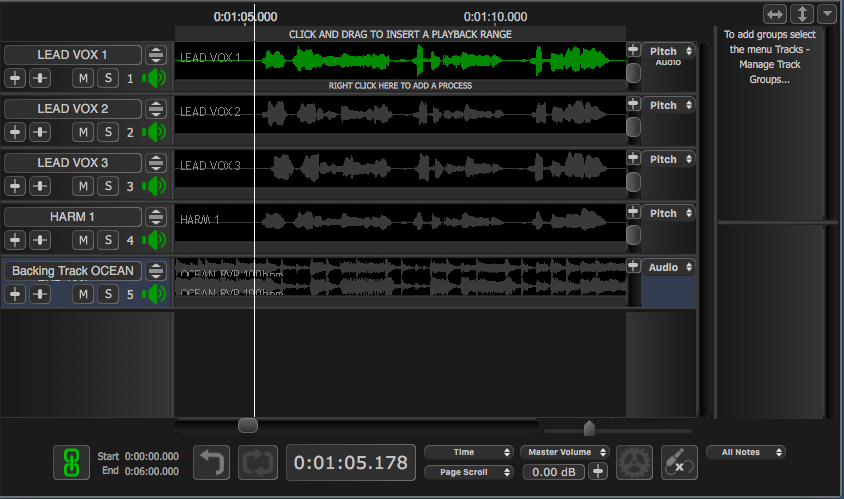
TIP: If clipping is heard when playing multiple tracks simultaneously, set Revoice Pro's Master Volume control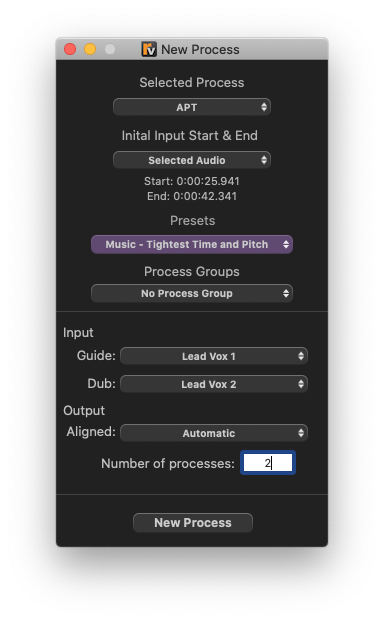 lower (e.g. to -6 dB).
lower (e.g. to -6 dB).
- Open the New Process window shown right by either
- Pressing the keyboard "B" key or
- RIGHT CLICK in a Process Control track to bring up the menu and select New APT.
- Make sure APT is the Selected Process.
- Check the Initial Input Start & End relates to the audio you want to process
- Set the Processing Preset (Optional)
In the image shown right, the Preset is set to "Music - Tightest Time and Pitch".
If a Preset is not selected, the "Default User Preset" will be selected.
The processing for each individual APT can be modified later as well.
- Set the process Inputs for Guide and Dub audio:
- In this example the Guide is set to Lead Vox 1, and the first Dub to be processed is set to Lead Vox 2.
- Select the Output track for the Aligned audio:
- Automatic selects the output track for you, creating or using a suitable free track or tracks, and maintains a connection between input and output tracks even if they are moved.
- Manual track selection can be done by using the Output drop down menu to select the track that will receive the first of the multiple APT outputs.
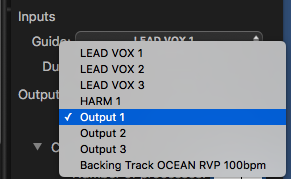 (In this case you may need to add new audio tracks first, if they don't already exist.)
(In this case you may need to add new audio tracks first, if they don't already exist.)
In the figure shown right, we have clicked in the Output dropdown control and selected the track "Output 1". - Set Number of Processes:
- In this example Number of Processes has been set to 2, to create one APT process for each of the two Dub inputs (Lead Vox 2 and Lead Vox 3).
- Create the new Processes by pressing the keyboard "N" key or clicking the "New Process" button.
- As seen below, two APT process output tracks have been created, which use "Lead Vox 1" as the Guide input.
- The Process Control Blocks are all the length of the audio that was initially selected.
- The Dub Process Control Blocks have been inserted into Tracks Lead Vox 2 and Lead Vox 3.
- Two Output tracks have been created in the Output tracks "Output 1" and "Output 2" (the output tracks were selected manually, rather than automatically).
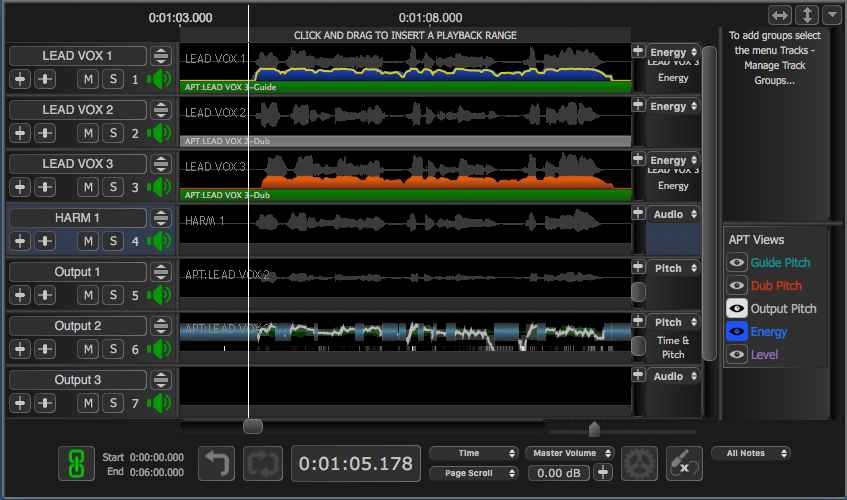
- OPTION: After processing, you can inspect and change any of the APT process settings
- Do this by clicking an Output, or a Dub Process Control Block, (or select a Guide process control block). Then you can press the keyboard P key (or click the black triangle in a Process Control Block if visible - (they are NOT shown in the screen above) and the APT control panel will appear.
- TIP: If the APT Process Settings are not correct, you can:
- Change the settings to what is desired, and save these as the Default User Preset.
- Then, use UNDO commands until you UNDO the insertion of the multiple Processes.
- Then return to Step 9 and recreate the processes with that preset.
- OR just change the settings for each APT one at a time.
- Play the Outputs
- As shown in the screen above, the two APT processes have created processed audio in tracks numbered 5 and 6 (Output 1 and Output 2 respectively.)
- TIP: To set up auditioning of just the multiple Outputs with the Guide Input, if the track count is under 10, you can press the keyboard numeric keys to toggle the solos on (or off) for tracks 1, 5 and 6, or any other combinations. For tracks with number above 10, then you can click the Solo or Mute buttons in the Track.
- However, to hear one APT at a time, the Process-based Solo switching will be effective for any number of tracks. By selecting either a APT Process' output audio or an APT's Dub Process Control Block then, use the Quick Solo Keys, G, D, A, E, F or G, the Inputs and Outputs of that APT can be Soloed in any combination.
- For example, in the image right (where APT Lead Vox 2-Dub is selected) the E key on the keyboard Solos the Guide Input (In track 1) and the Output 1 in track 5 containing the processed APT Lead Vox 2-Dub.
- TIP: Reminder - How to view only the Tracks of one APT.
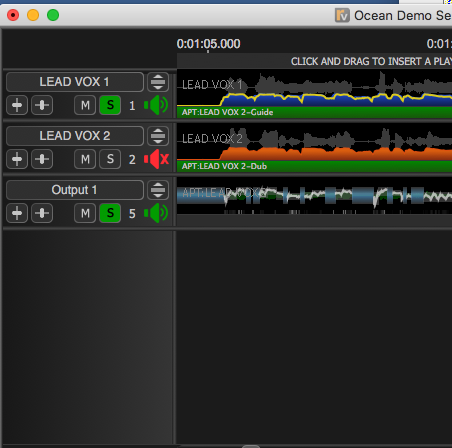 When the APT input and output tracks are spread out in a session as shown above on the left, one way to help audition and work with one APT at a time is to focus in on the APT. To do this, select either the Dub Process Control Block or Output audio of the APT of interest, and press Z on the keyboard. This will hide all tracks except the Input Guide, Dub and Output tracks for that APT process, as shown right.
When the APT input and output tracks are spread out in a session as shown above on the left, one way to help audition and work with one APT at a time is to focus in on the APT. To do this, select either the Dub Process Control Block or Output audio of the APT of interest, and press Z on the keyboard. This will hide all tracks except the Input Guide, Dub and Output tracks for that APT process, as shown right. - If you want to increase the height of the shown tracks, also select the commend Tracks /Auto Size Track Heights or drag the bottom of one track while holding down shift. Pressing X restores all the processes to view. Click here for more details.
- TIP: If the pitch traces are not shown, the slider at the right of each track can be moved to locate the pitch trace and optionally pressing SHIFT allows all pitch traces to be moved together.
- The APT audio, energy, pitch, and signal level displays can be controlled in the APT Views control panel and track display controls.